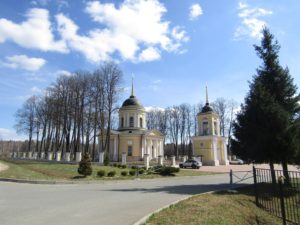
Our church has great and centuries-old history. Talezh village was firstly mentioned at the Spiritual Charter of Muscovite Prince Ivan Danilovich Kalita. The Grand Prince made the last will and testament leaving his lands to the sons before a fateful tour to the Golden Horde when scattered Russian lands started to unify into the unitary state. Talezh village was given to Andrew, his younger son (dated 1339). Talezh possibly was determined as a village since it had a church even at that time.
In those far-off days Talezh was the part of Ryazan Principality, having its outpost fortress city Khatun’ located on the left bank of Lopasnya River. In XIV century Serpukhov princes held Khatun’. It was not mentioned as the part of Ivan Kalita’s last will and testament gifted to his son Andrew. But Ivan’s grandson Vladimir the Brave held Khatun’.
Talezh church was formally mentioned in 1628. The Church of Saint Vladimir in Talezh was specified at the first Census after the Time of Troubles. The census book of 1646 says “Khatun’ District has Czar’s palace villagery….village Talezh on the river Talezh with the Church of Saint Vladimir, the household of priest Osip Stepanov, the household of a widowed priest Fyodor Melentiev, and 5 peasants’ households with 17 persons in them”.
In 1708 Czar Peter I Alexeevich granted Talezh to Count Gregory Fyodorovich Dolgoruky.
Next Census of households and people was made in 1709. Priest Avtonom Paramonov served at the Church of Saint Vladimir.
In September 1772 Catherine II granted Khatun’ palace villagery to Count Alexey Grigorievich Orlov in gratitude for the victory in the Battle of Chesme.
Later, in 1783 Chesme Count Orlov bought the villages to his brothers: Gorki village to Fyodor Grigorievich, and Talezh, Avdotyino, Ivanovskoe villages to Vladimir Grigorievich.
Vladimir Grigorievich Orlov was the youngest of five Orlov brothers. He started to improve his estates after the resignation as the President of the Russian Academy of Sciences. Count Vladimir Grigorievich Orlov
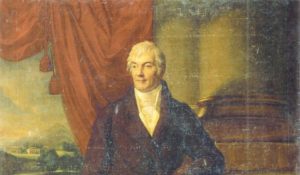
A new stone Church of the Nativity of the Theotokos was built when he owned Talezh. In 1792 the Church was built by Count’s bond architect Ivan Babakin upon the project of Moscow architect E.S. Nazarov. “First church exterior, such as the cross-form stone building, remains the same up to now; but the top consisting of five high spires with the cross, … in 1846 was replaced by the large dome (octagon) with a small head made of white iron. The overall church square is 29 archines (812 inches). Stone bell tower stays also the same, namely it is built as a separate building standing at a distance of 7 sagenes (14,91 meters) from the church. It is not built according to the plan for unknown reason; bell tower’s two central stores are shortened; thus, it seems well below the church. The church and the bell tower are surrounded by a vast fence made of white stone with wooden grid.”
On December 22, 1793 newly-built church was consecrated and devoted to the Nativity of the Theotokos, and as a memory of the dismantled same-name church in a neighbor village Gorki.
The artist Krasovsky painted icons for a new church. In addition to painting, some icons and church plate were carried from dismantled Churches of Nativity of the Theotokos and Saint Vladimir. Count Orlov not just paid all the works, but also took an active part in construction, as well as in buying additional church plate. “There the most outstanding holy thing is a silver, gilt, vershok thick Cross with Saint Vladimir relics, known to be life-giving and salutary, as overall verbal story tells it. Parishioners and by-stander church-goers, in great number, come to honor the relics on July 15, memory day of Saint Vladimir. According to the verbal story, the Cross with relics has been gifted by the church-builder Count Vladimir Grigorievich Orlov. Besides, people honor ancient icons long existing at the church. They were moved from former Church of Saint Vladimir in Talezh, and Church of the Nativity of the Theotokos in Gorki, and put in the special iconostasis. They are the Icon of the Savior “Not-Made-By-Hands”, Iveron Icon of the Mother of God, and the Icon of Nativity of the Theotokos, the Saviour Icon, Saint George the Victorious Icon, Saint Nicholas and Michael the Archangel Icons. These very icons are in copper silver plating. Their painting was never corrected.”
After that, in 1794 wooden near-standing Church of Saint Vladimir was dismantled. All wooden parts were used to bake bricks for the fence of a new church.
The column like the chapel was set up in altar place of dismantled Church of Saint Vladimir. The rest place, with some adding under the former Church, was dug out and turned into the cemetery which existed till 1867.
In 1806-1842, Ilarion Irodionov Golosov was a church archpriest. In 1810 Saint Vladimir side alter was made thanks to Father Ilarion.
Since the northern part of the church was empty and the number of parishioners had been growing, the church clergy in Talezh headed by priest Ilarion Golosov in 1823 served the petition to Dmitrov Bishop Afanasy (Telyatiev): “to make Michael the Archangel cold side altar at the expense of the parishioners.” The icons of four evangelists from the dismantled Church of the Nativity of the Theotokos in Gorki were set into the Holy Gates of a new side altar.
The number of church parishioners had grown due to the annexation of former big village Ananyino. Thanks to that in 1820, a rear deacon position was opened in the church.
In 1819 Count Orlov’s house serf A.G. Shershnev had donated the bell of 187 puds (2992 kg) 10 pounds, casted in Moscow at Bogdanov factory for the Church of the Nativity of the Theotokos.
In 1832 Talezh church clergy served the petition to Holy Hierarch Philaret (Drozdov), Moscow Metropolitan, to consecrate a new side altar. The Holy Hierarch wrote brief instructions on the petition, that said, “To charge Serpukhov rural dean to come to the church at all reasonable time (certainly after the Easter); carefully examine arranged side altar; and in case of positive results to celebrate the rite of the consecration under the regulation; to give the antimins for that purpose; and to deliver it with own clerical hands and with proper caution.”
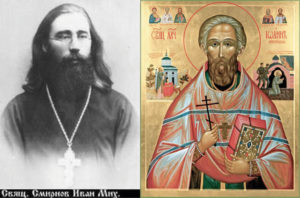
This year the side altar in the name of Saint Vladimir became warm.
In 1842 priest Ilarion Golosov was changed by his son-in-law. Priest Pavel Yakovlevich Smirnov had been serving in Talezh church for 38 years. Father Pavel’s wife Paraskeva gifted him six children: Alexander, Nikolay, Ekaterina, Mikhail, Lavr and Olga. Later on, his son Mikhail became the priest of Lopasnya Church of St. Anne’s Conception and the father of hieromartyr, archpriest Smirnov Ivan Mikhaylovich.
The church-builder’s descendants, landowners Orlovs-Davydovs, continued to make their donations during the service of Father Pavel Smirnov. Spouses Vladimir Petrovich and Olga Ivanova Orlovs-Davydovs owned the village at that time. Olga Ivanovna was known to be pious and charitable. Thus, “Statistical information on initial church arrangement and further changes in village Talezh of Serpukhov District, Moscow episcopacy”, written by priest Pavel Velichkin, let us know that there “the most worthy thing among the Church plate is the cypress altar cross coated with silver and gilt, having the following beaten words: “Just as Moses lifted up the snake in the wilderness, so the Son of Man must be lifted up, that everyone who believes may have eternal life in him. The Cross is the guardian of the whole world, the Cross is the beauty of the Church, the Cross is the might of kings, the Cross is the strengthening of the faithful, the Cross, angel’s glory, and wound to demons”. The Cross is donated by Countess Olga Ivanovna Orlov-Davydov in 1855. There is also the antient altar Gospel in a sheetlet of 1654, from former Church in Gorki”.
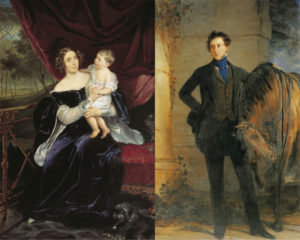
Priest Pavel Smirnov took an active part in the life of poor parishioners. The Manuscript Division of the Russian State Library saves his letters to Countess Olga Ivanovna Orlov-Davydov with the request of financial assistance to the poorest parishioners.
Further history of this village was vividly bound up to the church.
The important event of not just church but further life of all Talezh became the opening of the Talezh School in 1844 by Countess Olga Ivanovna Orlov-Davydov for education of local children in spirit of faith and church. Parochial school was the first one in Serpukhov District.
The Church was being reconstructed along with that. The large dome (octagon) with a small head of white iron replaced five spires. It took place in 1846. The Church was not reconstructed from that time.
Later, priest Pavel Smirnov did his best to construct the school building in 1857. Initially, the school was arranged in the wooden church gatehouse, but then it moved to the new building constructed by Father Pavel. The construction went on until 1878. The construction trustee became merchant Ignat Carpov, together with some people who made their contributions to the construction. The diocesan administration awarded father Pavel Smirnov for his efforts under the school construction. Priest Pavel Smirnov became a teacher, and the money in amount of 36 rubles for education received from peasants, he shared between his two assistants at school. Deacon S.P. Sokolov was a teacher and an assistant there.
At the same time, the church was actively being decorated. In 1871 the church walls were painted with the pictures from the Holy Scripture. There were painted new icons at the iconostasis in the side altar of Nativity of the Theotokos. They were a fascinating big Icon of St. Alexander Nevsky, “created in foreign manner and presented by parishioners forever, in the memory of peasants liberation from serfdom on October 17, 1861; Life-giving Holy Cross copied from Dmitriev Cross; and metallic gonfalon in memory of the miraculous event of October 17, 1888; remarkable ancient books: the Octoechos, the Holy Bible, the Service book and especially a hand-written Book of Akathists. The books are of unknown publishing dates, as the first pages are lost.”
In the period of father Pavel service, there was kept parochial chronicle recommended in 1866 by the Holy Synod for each bishopric. In 1878, shortly, deacon P.K. Smirnov, the father of Hiero-confessor Pavel Fedorovich Smirnov, served with Father Pavel.
Thereafter, Fr. Pavel Vasilievich Velichkin changed priest Pavel Yakovlevich Smirnov. In 1875-1879 he was a teacher of the elementary school in village Bukhlovo of Volokolamsk parish, at Moscow province. In 1879 Holy Hierarch Innokenty (Veniaminov), Moscow and Kolomna Metropolitan, ordained him as a priest and send him to Talezh as Pavel Vasilievich got married with Olga Pavlovna, the daughter of Talezh priest Pavel Smirnov.
Priest Pavel Vasilievich had lived his entire life in Talezh. The priest wholly devoted his life to pastoral care in its different aspects. He made a great contribution to prettifying the country church built at the end of XVIII century. Particularly, in 1885 Father Pavel changed faded wooden grid of the fence into new metallic ones. In 1899 he made hot-air heating for the Church. In 1901 thanks to Father Pavel efforts the Church was perfected, and a memory scripture on the south-east wall had saved it, “Once again the church has been perfected thanks to the care of parishioner A.D. Knyazeva and others, and efforts of Fr. Pavel Velichkin, Deacon M. Smirnov, parish clerk V. Podobedov, churchwarden I. Knyazev, in the year of 1901 Anno Domini.”
The manuscript written by Father Pavel on June 21, 1892 for the Committee on history statistical description of the churches in Moscow episcopate is of great value. It is called “Statistical information on the church structure and the following changes made, — village Talezh of Serpukhov District, Moscow episcopate”. The manuscript keeps valuable information on the church structure, holy things and patronal festivals. It is saved at the Fund of a famous Moscow expert M.I. Alexandrovsky, at the department of hand-written sources of the State Historical Museum.
Father Pavel paid much attention to school education as well. When he was appointed for Talezh church, he had been working as a catechist in two Talezh schools: in a country school until 1898, and in a parochial one until 1910. The priest was also an administrator of the parochial school. Altogether, in 1892, Father Pavel had constructed the building for a School of reading and writing. Hieromartyr Vladimir (Bogoyavlensky), Moscow and Kolomna Metropolitan, visited Talezh parochial school in 1905 and granted priest P. Velichkin the certificate of acknowledgement and the book “Conversations on childrearing” for the efforts in the field of education.
Thus, Talezh became not only an ecclesiastic but also an educational center.
The life of Anton Pavlovich Chekhov in Melikhovo just fell at the years of Fr. Pavel Velichkin priorship. The writer had lived in Melikhovo since 1892 till 1898.
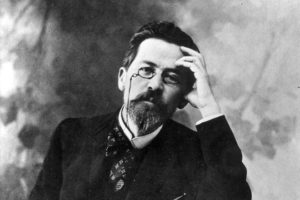
A.P. Chekhov is known to be not only a writer, but also a physician and a public man in Serpukhov District. When there raised the issue on choosing a trustee for the school in 1894, peasants of villages Bershovo, Maltsi, Popovo and Dubechnya came to A.P. Chekhov in Melikhovo. They asked him to become a trustee of Talezh school, and the writer agreed. But the next elections of a trustee developed into disputes. Residents of the above-mentioned villages wanted to choose again A.P. Chekhov, but the peasants of Talezh, Gorki, Shelkovo and Polusholkovo offered for this position Talezh peasant Dmitry Petrovich Chesnokov. The dispute was solved by Fr. Pavel Velichkin. Thanks to his and Talezh teacher Alexey Mikhailov intercession, a trustee was chosen again A.P. Chekhov.
Shortly after, he invited Father Pavel to his estate to celebrate New Year 1895. That time together with the priest, there was Talezh teacher A.A. Mikhailov, who went on visiting A.P. Chekhov after the event. The diary notes of writer’s father P.G. Chekhov acknowledged that fact.
After his election, A.P. Chekhov began the construction of a new school. And the opening ceremony of Talezh school took place on August 4, 1896. Children of all neighbor villages and countryside studied at the school.
Fr. Pavel Velichkin never forgot about his parish. Active construction of country chaples during Father Pavel Velichkin service. Part of the chapels was built on the place of dismantled churches in neighbor villages.
In 1908 priest Pavel was awarded hypogonation for his eager sermon. In 1912 he was a father confessor of the 4th rural district and Talezh was the part of it. In 1914 he was awarded the purple skouphos, and in 1918 the kamelaukion.
The parish of the Church of the Nativity of the Theotokos amounted to 1732 persons at the beginning of XX century. They were residents of Polushelkovo, Shelkovo, Popovo, Gorki, Zavolipyevo, Maltsi, Bershovo, and Ananyeno. The Church was white at that time, and it was decorated with 3 wooden and locally gild iconostases, and floor was wooden. The church held about 780 persons.
Priest Pavel Velichkin died in 1920. He had served in Talezh more than forty years. He left a great house with the garden of twenty apple trees.
Regardless of tumultuous times, church dean Fr. Mikhail Alexeevich Smirnov was ordained as a priest, and parish clerk Vladimir Vasilievich Podobedov was ordained as a deacon. The Church community invited parish clerk Petr Vasilievich Alexeev and lodged him to standing empty house of Fr. Pavel Velichkin.
Priest Mikhail Alexeevich Smirnov was born in 1870 in the family of a sacristan. In 1889 he ended the Bethany Theological Seminary. In October, 1891 he was ordained as a deacon of Talezh church by Moscow and Kolomna Metropolitan Ioanniky (Rudnev). In 1893 – 1906 he was a teacher in the Talezh parochial school. In 1907-1910 he was a catechist at the country school of neighbor Chirkovo, in 1899 — at Talezh school, and beginning from 1910 — at Shelkovo country school.
In 1927, Talezh parish planned to reconstruct the church. And for that purpose, the church community offered to Talezh residents to sell the empty priest house, that was the village property. But in the autumn of 1927, the general meeting of village citizens put forward another proposal to sell the house and buy agricultural machinery for money made from the bargain. In 1928 the house was sold out to the Local District Executive Committee. Part of the money made was used for buying a bull. And the rest part was lost no one knew where. But the Committee didn’t hurry to buy agricultural machinery.
When the Nunnery in the name of the Mother of God Icon «Comfort and Joy», located in several kilometers of the church, was closed in later 1920, five nuns moved to Talezh and lived there. Their names are saved. They were Agafiya (Shekhordanova), Evdokiya (Antsupova), Maria (Korotkova), Paraskeva (Shekhordanova) and Khioniya (Sopova). Nuns Agafiya and Evdokiya were church cleaners; nun Mariya hold the servise of a parish clerk; and nuns Paraskeva and Khioniya guarded the church.
Fr. Mikhail was changed by priest Sergiy Pavlovich Smirnov at this time, namely on September 24, 1929. As the contemporaries witnessed, Fr. Sergiy ambitiously stood against closing the church: held prayer services; called parishioners, the number of which had grown to 749 thanks to his efforts, to save the Church from closing; and collected money for paying the tax for the church. When neighbor churches were closed, and Fr. Sergiy went on to pastor bereaved parishes.
Thanks to his efforts, in 1930 there was arranged celebration of the Dedication day. Serpukhov Episcope Ioasaph was invited. He held service two days running.
The time of churchmen arrests began. The priests of our church shared this fate. In 1931 former priest Fr. Mikhail Smirnov and two nuns Agafiya and Evdokiya were exiled to Kazakhstan. Fr. Sergiy together with the rest three nuns, Mariya, Paraskeva and Khioniya, were enclosed in the Corrective Labour Camp. But Fr. Mikhail was soon set free and went back to the village.
Priest Pavel’s house is miraculously saved till our days. According to M.N. Strelkova, the house was transferred from Talezh to Ananyino in 1935.
By this time nuns Maria and Paraskeva got free and moved back to Talezh in 1936. Nearly in spring 1937, they went to live in village Popovo, where they stitched blankets. Then they went to work as nurse’s aide at the Health Resort “Nerastannoe”. There they lived until the next arrest, in March 1938.
The church was closed together with other churches of Russian Orthodox Church in 1939. The temple built on the place of Saint Vladimir Church was destroyed but later restored. The Church was long in tatters.
At the beginning of 1970s, the church building was used as a community centre, but in middle 1970s it stood opened and got started to ruin. The bell tower spire broke down at the beginning of XXI century.
The church revival was so long-awaited event. It started from attaching the Church of the Nativity of the Theotokos to the Ascension David deserts (monastery) in 2006. The reconstruction of the ruined relic and spiritual life began.
The outer works were already made in 2007-2008. There were plastered the Church walls, mounted cooper roof, and raised domes.
The orderly divine services on Saturday, Sunday and other holidays started to be held beginning from 2011.
The next stage was the wall painting in the church. The prayer service was held before the beginning of the painting and making iconostasis. That took place on February 15, 2013, at the Purification of the Blessed Virgin Mary Feast.
The Great Bell in the Church of the Nativity of the Theotokos bell tower was blessed and mounted on March 28, 2013. The bell weighted 156 puds (2700 kg) has four icons of: Saint David – the founder and the patron saint of the Ascension David deserts; Saint Vladimir – the right-side altar patron saint; Michael the Archangel — left-side altar patron saint; and Saint Nicholas.
Metropolitan Yuvenaly of Krutitsi and Kolomna, celebrated the rite of the Great Consecration and led the Divine Liturgy. The event took place on September 9, 2014.
The church was rebuilt in the former gorgeousness. Golden stars shine in the Dome. Church walls are decorated with paintings telling us the evangelic events, and about Saint David of Serpukhov – the founder of the Ascension David deserts.
Up to now people go hire to pry, take refuge and recovery.
Sacred Spring
The Sacred Spring of Saint David of Serpukhov exists near the Church of the Nativity of the Theotokos. Here he used to pry according to the verbal story. On the Sacred Spring there are the temple in the name of the Mother of Gog Icon “Life-giving Spring”, the temple in the name of Saint David of Serpukhov, the bell cote, and male and female bathing-places.
The Sacred Spring of Saint David of Serpukhov is the Ascension David deserts podvorye (metochion).
Working hours:
The Sacred Spring is open to visitors from 8 a.m. to 21 p.m. hours.
The church store and the tea-house are open:
in summertime (from May1 to October 1)
- from 9 a.m. to 19 p.m., on weekdays,
- from 9 a.m. to 20 p.m., at the weekends and on holidays,
in wintertime (from October 1 to April 30):
- from 9 a.m. to 18 p.m. on weekdays,
- from 9 a.m. to 19 p.m. at the weekends and on holidays.
Monday is a cleaning day. The Sacred Spring, the church store and the tea-house are closed.
Visiting rules and Father Superior orders work at the territory of the Sacred Spring.